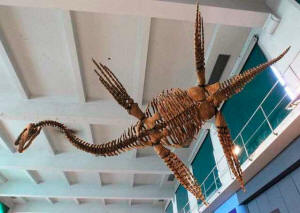|
 Ancient
'Loch Ness monster' reptiles swam like penguins Ancient
'Loch Ness monster' reptiles swam like penguins
 Send a link to a friend
Send a link to a friend
[December 18, 2015]
By Will Dunham
WASHINGTON (Reuters) - Plesiosaurs, marine
reptiles that thrived in the world's seas when dinosaurs ruled the land,
swam much like penguins by using their flippers to "fly" underwater,
scientists said on Thursday, resolving a debate that began nearly two
centuries ago.
|
|
 Plesiosaurs had four large flippers, and many had remarkably long
necks. They lived from about 200 million years ago to 66 million
years ago, disappearing in the same mass extinction that doomed the
dinosaurs. Nessie, Scotland's mythical Loch Ness monster, often is
portrayed as looking like a plesiosaur. Plesiosaurs had four large flippers, and many had remarkably long
necks. They lived from about 200 million years ago to 66 million
years ago, disappearing in the same mass extinction that doomed the
dinosaurs. Nessie, Scotland's mythical Loch Ness monster, often is
portrayed as looking like a plesiosaur.
The researchers conducted a series of computer simulations based on
the anatomy of a plesiosaur from 180 million years ago called
Meyerasaurus to find the most effective swimming strategy for this
body design.
The method that produced the fastest forward speed was flapping the
two front flippers up and down in an underwater flying motion
similar to penguins and sea turtles.

"What was unexpected was that no matter what motion we simulated for
the back flippers, they could not substantially contribute to the
plesiosaur's forward motion," said Georgia Institute of Technology
computer science professor Greg Turk.
The back flippers were probably used to steer and provide stability,
said the researchers, whose work was published in the journal PLOS
Computational Biology.
Plesiosaurs, which ate fish and squid, came in various shapes and
sizes, some with shorter necks and others with lengthy ones like
Elasmosaurus, a creature about 46 feet (14 meters) long.
Meyerasaurus, unearthed in Germany, measured 10 feet (3 meters)
long.
"The plesiosaurs were a highly successful group of large predatory
creatures, yet we didn't know how they swam. Their body plan wasn't
an isolated fluke, pardon the pun, because the history of
plesiosaurs stretched over 135 million years and dozens of species,"
Turk said.
[to top of second column] |

Plesiosaur fossils were first described in 1824. Ever since,
scientists have debated how they swam.
"Plesiosaur swimming has remained a mystery for almost 200 years
because it is difficult to determine how an extinct animal with a
unique body plan moved," said paleontologist Adam Smith of Britain's
Nottingham Natural History Museum.
There have been some competing hypotheses, Smith added, with some
researchers suggesting plesiosaurs moved their limbs mostly
backwards and forwards, in a rowing motion.
The underwater flying method is unusual because swimming creatures,
including most fish and whales, tend to generate thrust using their
tails, Smith said.
"Plesiosaurs are truly weird and unique creatures," Smith said.
(Reporting by Will Dunham; Editing by Jonathan Oatis)
[© 2015 Thomson Reuters. All rights
reserved.]
Copyright 2015 Reuters. All rights reserved. This material may not be published,
broadcast, rewritten or redistributed.
 |